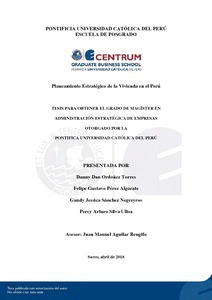| dc.contributor.advisor | Aguilar Rengifo, Juan Manuel | |
| dc.contributor.author | Ordoñez Torres, Danny Dan | es_ES |
| dc.contributor.author | Pérez Algarate, Felipe Gustavo | es_ES |
| dc.contributor.author | Sánchez Negreyros, Gaudy Jessica | es_ES |
| dc.contributor.author | Silva Ulloa, Percy Arturo | es_ES |
| dc.date.accessioned | 2018-07-30T21:35:21Z | |
| dc.date.available | 2018-07-30T21:35:21Z | |
| dc.date.created | 2018 | |
| dc.date.issued | 2018-07-30 | |
| dc.identifier.uri | http://hdl.handle.net/20.500.12404/12358 | |
| dc.description.abstract | Las viviendas con condiciones adecuadas son una necesidad básica de las personas
debido a que son primordiales para la seguridad, la salud y la dignidad humana, elementos
que contribuyen a desarrollar su potencial. A pesar de que el Índice de Progreso Social (IPS)
2017 ubicó al Perú dentro de una clasificación «Alta» (Porter & Stern, 2017), los resultados
del IPS Regional pusieron en evidencia las grandes diferencias sobre las condiciones
habitacionales que existen al interior del país, con mejores condiciones en los hogares de la
mayoría de las regiones de la costa, ubicándolas en las clasificaciones «Alta» y «Muy alta»;
y, por el contrario, las escasas condiciones en la mayoría de las regiones de la sierra y selva,
ubicándolas en las categorías «Baja» y «Muy baja» (CENTRUM Católica Graduate Business
School [CENTRUM] & Social Progress Imperative [SPI], 2016a).
La presente tesis propone un plan estratégico del sector vivienda para el Perú que
busque corregir la actual situación, homogeneizando o reduciendo las diferencias entre las
regiones y brindando especial énfasis en las familias de escasos recursos que, por lo general,
se encuentran ubicadas en zonas rurales alejadas, adonde no llegan los servicios básicos de
agua, luz y otros con que gozan las zonas urbanas, pero sin descuidar el desarrollo en estas
últimas. Esta realidad de lejanía y desconexión con los servicios básicos de los hogares
rurales sugirió la necesidad de plantear estrategias innovadoras para abordar el problema
habitacional dado que pensar en que los servicios llegarán de forma tradicional es utópico y
esperar a que las familias abandonen sus hogares también lo es.
El presente plan estratégico fue elaborado aplicando el Modelo Secuencial del
Proceso Estratégico propuesto por D’Alessio (2015) que, mediante una serie de pasos que
involucra principalmente un profundo análisis de las potencialidades del país, la evaluación
de los factores externos, el análisis de los competidores y referentes —otros países—, la
evaluación de los factores internos y un conjunto de herramientas de selección y filtro, busca
encontrar los caminos —estrategias— que permitan alcanzar la situación futura deseada | es_ES |
| dc.description.abstract | Housing with adequate conditions is a basic need of people because it is essential for
safety, health, and human dignity, elements that help to develop their potential. Although the
2017 Index of Social Progress placed Peru within a «High» classification (Porter & Stern,
2017), the results of the Regional Social Progress Index highlighted the great differences in
housing conditions that exist within the country, with better conditions in the homes of most
of the regions of the coast, placing them in the «High» and «Very high» classifications and,
on the contrary, the scarce conditions in most of the regions of the mountain range and the
jungle, locating them in the «Low» and «Very low» categories (CENTRUM & SPI, 2016a).
This thesis proposes a strategic plan for the housing sector of Peru, which seeks to
correct the current situation, homogenizing or reducing differences between regions and
giving special emphasis to low-income families, who are usually located in remote rural
areas, where the basic services of water, electricity, and other services enjoyed by urban areas
do not reach, but without neglecting development in urban areas. This reality of remoteness
and disconnection with the basic services of rural households suggested the need to propose
innovative strategies to address the housing problem, since thinking that the services will
arrive in a traditional way is utopian, and to expect families to leave their homes is also
utopian.
This strategic plan was prepared applying the Sequential Model of the Strategic
Process proposed by D’Alessio (2015), which through a series of steps that mainly involves
an in-depth analysis of the country’s potential, the evaluation of external factors, the analysis
of the competitors and referents —other countries«, the evaluation of internal factors, and a
set of selection and filter tools, seeks to find the paths —strategies— that allow reaching the
desired future situation. | es_ES |
| dc.language.iso | spa | es_ES |
| dc.publisher | Pontificia Universidad Católica del Perú | es_ES |
| dc.rights | info:eu-repo/semantics/openAccess | es_ES |
| dc.rights.uri | http://creativecommons.org/licenses/by-nc-nd/2.5/pe/ | * |
| dc.subject | Vivienda -- Perú | es_ES |
| dc.subject | Planificación estratégica | es_ES |
| dc.title | Planeamiento estratégico de la vivienda en el Perú | es_ES |
| dc.type | info:eu-repo/semantics/masterThesis | es_ES |
| thesis.degree.name | Maestro en Administración Estratégica de Empresas | es_ES |
| thesis.degree.level | Maestría | es_ES |
| thesis.degree.grantor | Pontificia Universidad Católica del Perú. CENTRUM | es_ES |
| thesis.degree.discipline | Administración Estratégica de Empresas | es_ES |
| renati.discipline | 413307 | es_ES |
| renati.level | https://purl.org/pe-repo/renati/level#maestro | es_ES |
| renati.type | https://purl.org/pe-repo/renati/type#tesis | es_ES |
| dc.publisher.country | PE | es_ES |
| dc.subject.ocde | https://purl.org/pe-repo/ocde/ford#5.02.04 | es_ES |






